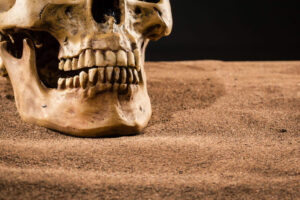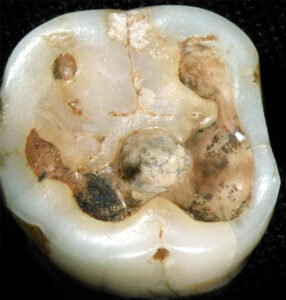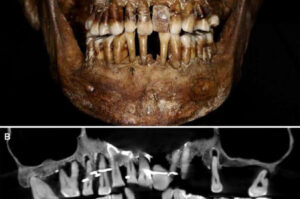 From ancient fillings and gold dental appliances to identifying diseases and food by the DNA they left on teeth, archeologists are learning all sorts of fascinating things about ancient people from examining their teeth. Let’s explore some interesting discoveries of these scientific excavations!
From ancient fillings and gold dental appliances to identifying diseases and food by the DNA they left on teeth, archeologists are learning all sorts of fascinating things about ancient people from examining their teeth. Let’s explore some interesting discoveries of these scientific excavations!
Interesting Finds
*The oldest known dental fillings were found in Italy in a pair of 13,000-year-old upper front teeth (incisors)! Marks on the teeth show that they were drilled all the way into the pulp chamber. The fillings were made of bitumen (a semi-solid form of petroleum) with bits of plant fiber and hair that could possibly have been part of the fillings. The earliest filling known before this discovery was a beeswax filling, found in a 6,500-year-old jawbone from Slovenia.
*Ancient Egyptian writings explain 11 different ways to treat ailments of the mouth! Mummies have also been found with linen fillings that may have contained cedar oil or fig juice that would have been used as a medicine.
*In a neolithic graveyard in Pakistan that is believed to be 7,500-9,000 years old, researchers found 11 molars that had been drilled with flint tools. The drilled areas had been smoothed a bit, showing that they had been used for chewing. Hopefully, they had some form of filling – or that could have been painful!

(AP Photo/Luca Bondioli, Pigorini Museum, Rome)
*Even kids can make important discoveries! In 2015, a 16-year-old volunteer archaeologist dug up a large adult tooth. This excavation was from a site in southwestern France where the soil explored is said to be 550,000 – 580,000 years old. The tooth is the oldest fossil found in Europe. Before this find, the oldest was believed to be 450,000 years old. The tooth owner lived in a cave, and scientists have found many fascinating facts about this person from the Paleolithic era. They lived when the climate was dry, cold, and windy and hunted and ate horses, reindeer, bison, and rhinoceros.
*Anne d’Algre was an aristocrat in the 1600’s in France. Four hundred years after her death, scientists found her grave during the excavation of the area near the Chateau de Laval in 1988. Her skeleton, with her teeth intact, was preserved well enough that they were able to determine some interesting facts about this woman. She had an artificial ivory tooth of ivory from an elephant, not a hippopotamus, which was the popular choice in that era. She also suffered from periodontal disease that was loosening her teeth, and had a dental prosthetic of gold wire that held her teeth together! A doctor, Amboise Pare, who designed similar prostheses for French kings of that era, felt that “toothlessness” affected a person’s speech. Dental scientists state that this treatment would have been more harmful to her teeth as the prosthesis of gold wire would have pulled on the teeth on each side of the artificial tooth. It was essential to socialites of her time to have a nice smile, so even if the wiring caused pain, she would have endured it to “save face.”

(Image from Journal of Archaeological Science: Reports)
DNA, Diet, and Immunity
Would it surprise you to find that your dental plaque has DNA? That’s what scientists found when researching the teeth of humans that died over 3,000 years ago in the Bronze Age and Iron Age. Harvard Professor Dr. Christina Warinner, Ph.D., and those in her lab analyzed the dental calculus (hardened plaque) in human teeth found in the Mediterranean and South Asia regions. Scraping the hardened dental plaque of the teeth of ancient humans allows scientists to see traces of what they ate.
Warinner said, “Your dental plaque records a lot of things about you. It has your DNA. It says a lot about your immune system. But it also contains traces of food debris… It’s just this sort of kitchen sink of information about your life.”
Interestingly, they showed these two locations were probably connected by trade routes. People in the Mediterranean were eating exotic foods that came from South Asia, such as bananas, turmeric, and soybeans. They also learned that wheat, sesame seeds, and dates were common food staples.
Another group is making discoveries about ancient diseases from bacteria found on teeth. Scientists initially thought that the civilizations in the late third millennium BCE in the Eastern Mediterranean and Near East declined due to social and climate factors. Archaeologists have found that infectious diseases may also have had something to do with the lost societies. These researchers identified two bacterial strains in the teeth of these ancient human remains that cause typhoid fever and were responsible for at least three pandemics in ancient Europe. This research explains another reason the civilizations in other parts of the world may have become extinct.
Another scientist is looking at the teeth of people who lived along the Nile River between 6000 BC to AD 1500. She found that females in that area were more likely to have dental disease than males, and gum disease, abscesses, tooth loss, and even dental wear were different between males and females. This could mean that they had different diets or prepared food differently.
Letting Our Teeth Tell the Story
There is one final thing to mention that we learned from the past. In all of the stories and archaeological finds, one thing seems evident. Even though our ancestors didn’t have modern toothbrushes, toothpaste, or floss available, they seemed to have better oral hygiene than our generation. Most archaeological finds from ancient excavation sites have shown fewer oral bacteria strains due to the early human diet. They ate more fibrous foods and chewed sticks and stalks, helping scrape debris from their teeth and build strong jaws. Through the centuries, we have added refined sugar, carbohydrates, and grains to our food, and the result is that the plaque on the teeth of humans has absorbed more bacteria. This bacteria has caused more susceptibility to dental hygiene issues, including a buildup of plaque and tartar on the teeth, cavities, and even gingivitis.
This doesn’t have to be our future! It is possible to have a healthy mouth and teeth. At Jungle Roots Dentistry, we want to educate and provide treatment to help your kiddos begin a lifetime of optimal dental health. Philipp Stockhammer, an archeologist from Munich, said, “Anyone who does not practice good dental hygiene will still be telling us archaeologists what they have been eating thousands of years from now.” We really do not want the scientists of the future to find our teeth showing signs of decay and oral disease!














